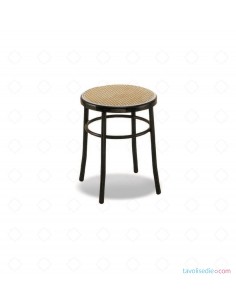
In order to discover the value and authenticity of an object or furniture, it is important to make a careful examination, aimed at identifying the characteristics of the object or furniture. In order to give the right value to your furniture, it is important to learn to recognise an original thonet chair: certainly the identification and recognition process is not easy; in fact, specific skills are necessary to make a correct evaluation.
Only those who have the possibility to consult a documented archive will be able to recognise the authenticity of a piece of furniture or furnishings close to Viennese design. Any information may not be enough to recognise a real thonet chair without the experience of a professional who has worked for years in the field of this particular design.
Thonet design
The great history and tradition of Thonet style furniture and furnishings, is rich in important nuances: the Gebruder Thonet in Vienna is the first reality to have transformed a cabinetmaker's project into a great industrial colossus, perfecting and fine-tuning the art of bending beech wood with the help of steam.
![]()
The art of woodworking has evolved considerably over time, fuelling the birth of many companies in Europe. The companies that were gradually born, have consolidated their production of thonet furniture, starting to imitate the models of the industrial leader, both in the catalogue and in the nomenclature. The design objects have a documented history in catalogues, price lists, commercial documents, advertising, and internal newspapers of every single production company. Many people today love this style and design and collect chairs and furniture in thonet style.
The original Thonet chairs
The original Vienna straw chairs can boast an extraordinary success story that has now become a true legend: the thonet style chairs continue to fascinate and make many amateurs and admirers, as well as many collectors all over the world, fall in love.
Legend has it that in the circumstances of the 1889 Universal Exhibition in Paris, Michael Thonet's chair number 14 fell from the Eiffel Tower from a height of about 57 metres, remaining completely intact.
To the commercial success of the Thonet chairs, it certainly contributed, in addition to the great robustness of the furniture, attested by the experience mentioned above, also its particularly elegant and sober shape and lines, as well as the possibility of mass production, extremely revolutionary at the time of the Paris Expo in 1889. The Thonet chair was already awarded the bronze medal at the Universal Exposition in London in 1862: the Vienna straw seat, now known as model number 214, was sold in over 50 million pieces, only until 1930; perhaps the most famous and famous chair in the world, it still retains its great charm and character. Alongside all the versions proposed over the years by Thonet, there is a new version in German ash wood: this model was included in the "Pure Materials" collection in 2015.
History of the Thonet chair
The great success story of this world design icon began in 1841, when the famous Austrian Prince Clemens Von Metternich, Chancellor of Court and State, became aware of Michael Thonet's experiments in bending wood in Boppard and decided to contact the young Rhine cabinetmaker in person in the Austrian capital. In Vienna, the revolutionary cabinetmaker soon succeeded in bending solid wood too: the long wooden bars, made elastic by the effect of pressure and steam, were able to be bent and shaped to the desired shape.
The three-dimensional shaping of the solid wood undoubtedly caused a stir at the time: after the Viennese court orders, the Liechtenstein court and the Schwarzenberg Palace were also interested in the new avant-garde chairs for their respective palace furnishings. Soon, however, Thonet chairs became the symbol of the traditional Viennese cafés; the great commercial success and popularity of these furnishings is not only due to their great presence in public spaces such as the traditional Viennese cafés, but also thanks to the innovative manufacturing technique that made it possible, for the first time in the history of furniture, to operate a production that we can define as industrial and mass production of a chair.
The Thonet chair was in fact manufactured with the aid of a process based on a principle of division of labour, and was decomposable into only six elements. This allowed Thonet to send the model of his chair all over the world, storing as many as 35 disassembled chairs in a one cubic metre case, which were then assembled on site.

The fundamental stage of industrialization and storage of the Thonet chair allowed the company to start what would soon become the common history of modern furniture in normal industrial production processes. The original Vienna straw chair no. 14 is still produced today under model number 214 at the Thonet GmbH plant in Frankemberg, Hesse.
Characteristics of a Thonet-style chair
The immediately striking feature of a Thonet chair, so loved by fans of this style, is the characteristic curved wood that forms the back of the furniture. In our commercial offer, consulting our catalogue, you can find different models of Vienna chair type Thonet; our models are characterized by a high quality level: excellent workmanship and use of quality materials, at absolutely competitive prices, in reference to the market of the sector.
Consulting our catalogue, you can first of all see the characteristics of the model Vienna White Chair, type Thonet: it is a chair 100% made in Italy, ideal to be prepared in restaurants, bars, bistros, cafeterias, canteens, catering services and ice cream parlours. The minimum quantity that can be ordered for this product is 4 units.
The frame of the chair is made with the aid of a steel tube with a diameter of 25 mm, painted with white thermosetting powders. This model is made of polypropylene, imitating Vienna straw, with a white ring. Vienna Type Thonet Chair is available in black, red and silver. Also very interesting is the model Sedia Linz, which is perfect for use in domestic areas such as the kitchen and dining room.








